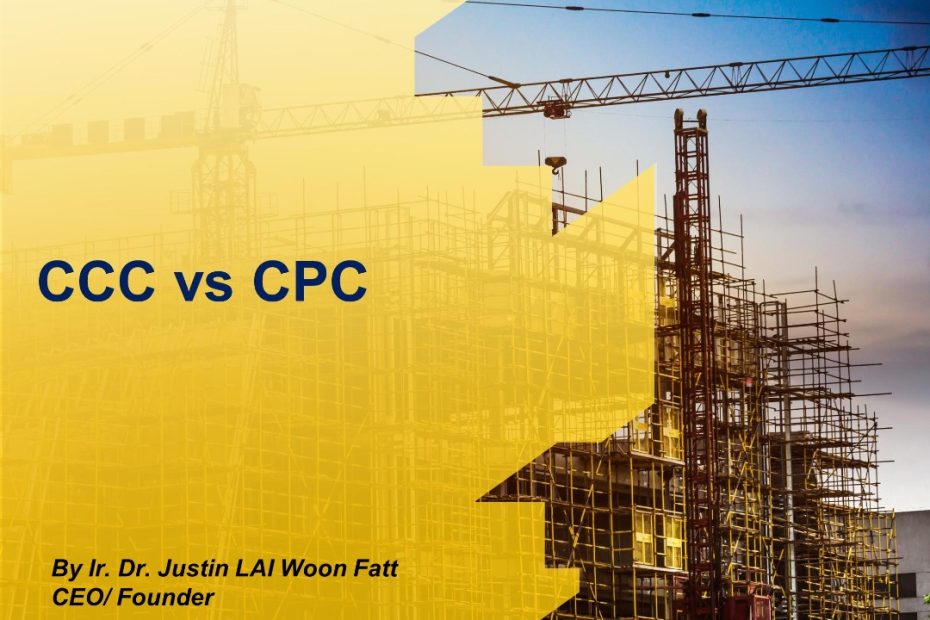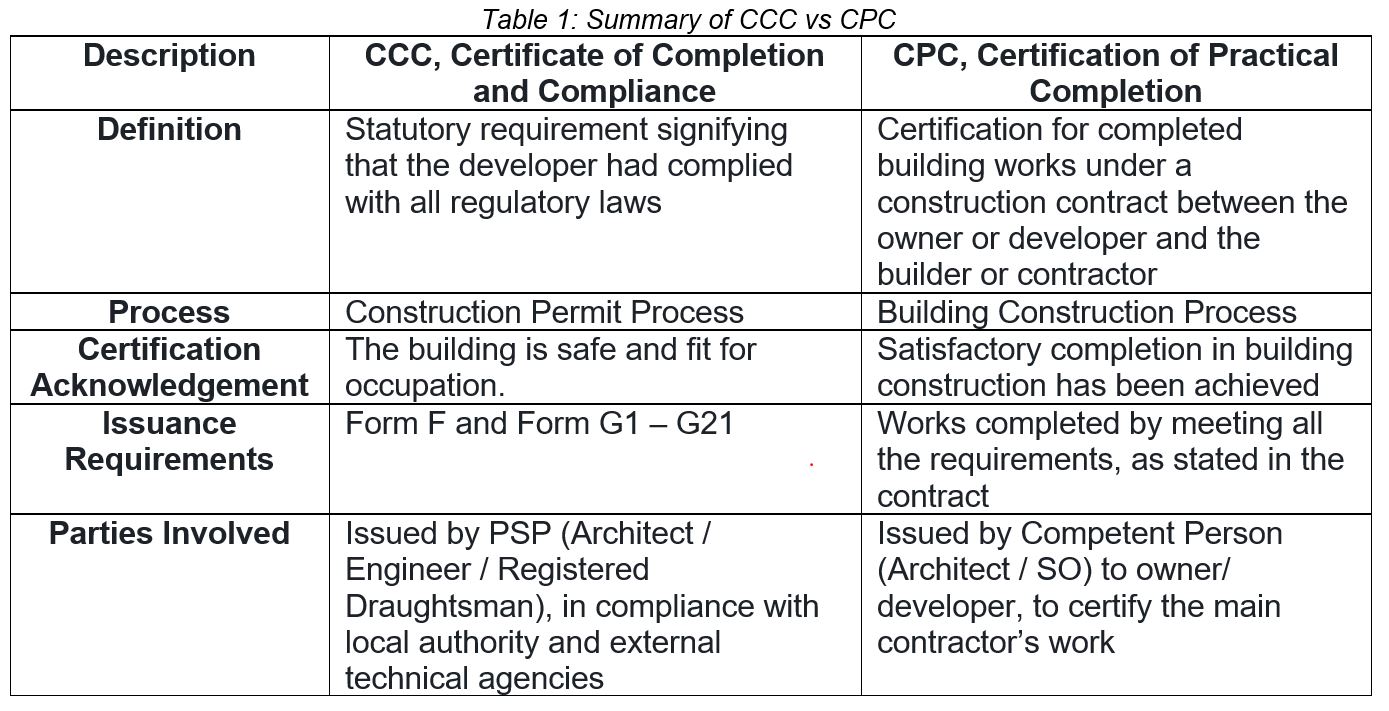Author: Ir. Dr. Justin LAI Woon Fatt | 28 July, 2022
Certificate of Completion and Compliance (CCC) and Certificate of Practical Completion (CPC) are parts of the building erection process to ensure the building is fit to be occupied. CCC is part of the Construction Permit Process whereas CPC is part of the Building Construction Process. Figure 1 shows the simultaneous process of gaining CPC and CCC along the same timeline.
CCC is a statutory requirement indicating that the developer has followed all regulatory regulations. In contrast, CPC is a certification for the completed building works under a construction contract between the owner or developer and the builder or contractor. Such certification is a private legal duty between the persons involved [1].
 DLP: Defect Liability Period
DLP: Defect Liability Period
CMGD: Certificate of Making Good Defects
FC: Fire Certificate (Refer to Cccupancy Hazard)
CERTIFICATE OF COMPLETION AND COMPLIANCE (CCC)
CCC, or ‘Perakuan Penyiapan dan Pematuhan’, is a certificate that certifies the completion of building construction. The granting of a CCC indicates that a property is now safe to occupy. It is a revision to the previous issuance, the Certificate of Fitness for Occupation (CFO), in 2007. The main reason for the upgrade is to transform the system into a self-certification and self-regulating issuing system [3]. Many changes were made with the implementation of CCC. For example, it was mandated that CCC be granted only by a registered professional known as Principal Submitting Person (PSP). CCC proposals benefit developers, building owners, and buyers by improving home buyer protection, reducing red tape in local government, and creating a more efficient public delivery system [4].
A professional architect, engineer, or registered building draughtsman are the PSP’s, who are registered under the relevant professional body registration statute, such as the Architects Act 1967 or the Registration of Engineers Act 1967 (Revised 1974). The PSP’s responsibilities include submitting building plans to the local authority for approval, supervising the building erection and completion in accordance with the approved plans and the provisions of Acts or by-laws, and ensuring that all technical conditions imposed by the local authority and external technical agencies such as Bomba, TNB, Syabas, TM, JPS (Road and Drainage), IWK (Sewerage), etc. have been duly met, and ensuring that the building is safe and fit for occupation. The PSP shall also accept full responsibility for the issuance of the CCC when he certifies that the building is safe and fit to be occupied.
In accordance with by-laws 25 in UBBL (Amendment) 2021, the PSP shall issue CCC (Form F) subject to the following conditions being met:
- All technical conditions imposed by the local authority have been met satisfactorily.
- Forms G1 until G21, which comprises 21 construction components relating to stage certification as set out in the Second Schedule, have been duly certified and issued.
- Essential services such as access roads, landscape, parking lots, drainage, sanitary, water, and electricity systems, fire hydrants, sewage and garbage disposal needs, and fire lifts have been installed.
- Certifies on Form F whereby the PSP had supervised the building’s erection and completion, and that, to the best of his knowledge and belief, the building is constructed and completed in compliance with Act 133, the UBBL, and the approved plans. [5].
CERTIFICATE OF PRACTICAL COMPLETION (CPC)
The Competent Person (Architect or Superintendent Officer (SO)) issues a CPC or ‘Perakuan Siap Kerja’ to the main contractor when all physical works for the development, as specified in the contract, are completed satisfactorily. According to the PAM Form of Contract 2018 [7],
“The works are practically completed when in the opinion of the Architect, the Employer can have full use of the Works for their intended purposes, notwithstanding that there may be works and defects of a minor nature still to be executed and the Contractor has given to the Architect a written undertaking to make good and to complete such works and defects within a reasonable time specified by the Architect; and other requirements expressly stated in the Contract Documents as a pre-requisite for the issuance of the Certificate of Practical Completion have been complied with.”
According to the state of Clause 39.0 for Completion of Works in PWD Form 203/203A (Rev 1/2010) [8], work completion should be:
- The contractor shall complete the whole of the works on or before the ‘Date of Completion’ as stated, or such extended time allowed under Extension of Time (EOT).
- If the contractor believes that the work has reached practical completion, the contractor shall inform the SO in writing, for the matter.
- Receiving such notice, SO will conduct testing/inspection of the works. The SO must:
- If, in his opinion, the entire project has attained practical completion and has passed any inspection/test, he will issue the CPC.
- Issue instructions to the contractor detailing all defective works that the contractor must complete prior to the issue of the CPC.
- The SO shall confirm the completion date, and this date shall be the date of DLP commencement.
After receiving CPC, the contractor will handover the work completion to the client, and if CCC has been obtained, building handover can take place as well as Defect Liability Period (DLP).
CONCLUSION
Building completion in a building construction contract denotes that the completion complies with the contract completion between the developer and the main contractor. This is verified by issuing the Certificate of Practical Completion, or CPC, which means the building should have been completed in accordance with the contract requirements, and all contractual requirements between both parties should have been met. Meanwhile, CCC is a stand-alone certificate that does not require CPC to be issued. Its purpose is to indicate that the building complies with the approved plans and the provisions of Acts or by-laws.
Ir. Dr. Justin LAI Woon Fatt
CEO/ Founder
IPM Group
References:
[1] “CCC, Not Partial CCC, is Mandatory Upon VP”, L. Kim, N. Ys, 2021. Retrieved on 26th July 2022 from https://www.edgeprop.my/content/1807358/ccc-not-partial-ccc-mandatory-upon-vp
[2] “Is CCC the Only Contractual Requirement for the Delivery of VP in a Sales and Purchase Agreement?”, R. Razak, 2018. Retrieved on 26th July 2022 from https://www.scribd.com/document/393449662/Is-Ccc-the-Only-Contractual-Requirement-for-the-Delivery-of-VP-in-a-Sales-and-Purchase-Agreement
[3] “Apa Yang Anda Perlu Tahu Mengenai Perakuan Siap dan Pematuhan”, Kementerian Perumahan dan Kerajaan Tempatan, 12 April 2007. Retrieved on 26th July 2022 from http://rehdainstitute.com/wp-content/uploads/2016/03/risalah_perakuan_siap_dan_pematuhan.pdf
[4] “Law & Reality: Understanding the New CCC”, Y. P. Cheong, 2007. Retrieved on 27th July 2022 from https://www.malaysianbar.org.my/article/about-us/committees/conveyancing-practice/law-realty-understanding-the-new-ccc
[5] “Homebuyer’s FAQ Guide to the Certificate of Completion and Compliance (CCC)”, PropertyGuru Editorial Team, 2020 Retrieved on 27th July 2022 from https://www.propertyguru.com.my/property-guides/common-faq-about-certificate-of-completion-compliance-ccc-malaysia-29736
[6] “Certificate of Completion and Compliance”. Retrieved on 27th July 2022 from http://rehdainstitute.com/certificate-of-completion-and-compliance/
[7] Malaysia PA. Agreement and Conditions of PAM Contract 2018 (with quantities). Kuala Lumpur: Pertubuhan Akitek Malaysia, 2018.
[8] Standard Form of Contract to be Used where Drawing and Specifications Form Part of the Contract, PWD Form 203/203A (Rev 1/2010)



